Side with Augustus
original south side
Processional Frieze - Panorama
and Far Left Section
Scholarly interpretation: The near life-size figures represented in the processsional friezes on the two sides of the surrounding precinct wall are presented as if walking along its two sides from the public approach front facing the Via Flaminia toward the ceremonial entrance front then facing the open fields of the northern Campus Martius. Whether or not an actual event is represented, and if so which, who is represented and indeed how many are real people or representatives of types, and many other aspects of these two carefully orchestrated prosessional friezes have formed the basis of continuing scholarly debate over the years. This has encouraged in-depth research on cultural practices, political and family relationships, clothing, even foot attire, and many other aspects of Augustan society, all of which have kept the Ara Pacis alive as a key monument in our interpretations of ancient Rome.
Within the world history of art, it is most notable that this is perhaps the first significant representation of a contemporay event approximately as it could have been seen by those present at the time. Even more impressively, it is a nearly unique example of the head of a great empire represented as a normal human being.
Originally there would have been over 90 figures on these 2 processional friezes, approximately half on each side. Most scholars now agree that they are to be seen not as 2 parts of the procession but rather as the same procession seen from 2 sides. The figures are represented as if moving very slowly, some pausing, perhaps engaged in quiet conversation. As spectators, we are thus encourgaged to move slowly ourselves along the full length of the two friezes, pausing to observe them individually and in groups.
We may see this processional frieze as divided into 3 parts by the 2 prominent, toga-wearing figures with recognizable portrait features, Augustus and Agrippa. However, they were not oriiginally spaced in exactly this way. Two of the large slabs toward the right were incorrectly joined in the hurried 1937-38 reconstruction. Remaining original details indicate that at least 2 figures, possibly more, now missing, would have stood between these 2 slabs. Thus the entire group of figures in the center would originally have been farther to the left, and the fragments at the far left would have been closer together (see esp. Foresta 2002). Because the number of missing figures at the far right is unknown, it is possible that Augustus would originally have stood much nearer to the front of the procession.
The fragments in the 6 photographs at the bottom of this page are rarely illustrated in print publications. Likewise, they have been considered too minor for restoration over the years. As a result, the authentic Augustan character and quality of the original carving has survived in these faces, notable especially when viewed close up when you zoom in.
TO ZOOM IN ON THE LARGE IMAGES, USE THE BUTTONS AT TOP-LEFT.
Tips for using this website

The space beside the Ara Pacis within the museum is narrow and the ground level outside a full story lower. photos July 2008, collage Tony Moreno
of this entire frieze, taken straight-on, comparable to the photograph on this website for the processional frieze on the opposite, north side of the Ara Pacis.
|
||
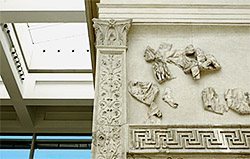 Because at least 2 figures are missing between 2 slabs toward the right of this frieze, which were mistakenly joined, and an unknown amount missing at the far right, these fragments would originally have been closer together. Because at least 2 figures are missing between 2 slabs toward the right of this frieze, which were mistakenly joined, and an unknown amount missing at the far right, these fragments would originally have been closer together.
photo July 2008
|
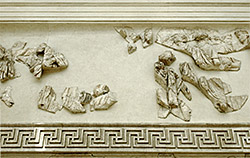
Because at least 2 figures are missing between 2 slabs toward the right of this frieze, which were mistakenly joined, and an unknown amount missing at the far right, these fragments would originally have been closer together. photo July 2008
|
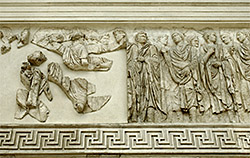
The figures behind Augustus are among the best preserved on either of the 2 processional friezes. photo July 2008
|
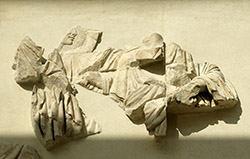
Detail of the photo above. Toward the upper-left in this photo, there is a low-relief carving of the front of a face in profile, high quality and well-preserved. photo Oct. 2008 |
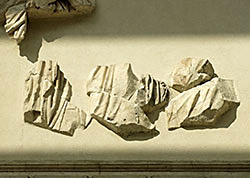
Detail of the photo above. Fragments of clothing. photo Oct. 2008
|
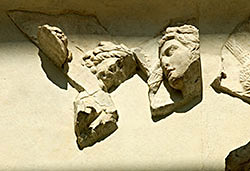
Detail of heads at top of photos above. The head with surviving face is generally identified as a camillus. photo May 2010 |
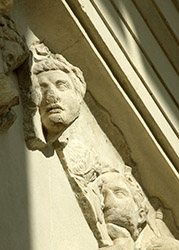
3 heads seen at a severe angle from below, the one at left, generally seen as a camillus, almost full-face. photo Oct. 2008 |
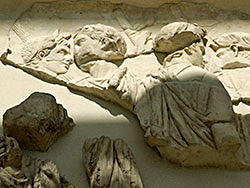
Fragments of figures next to Augustus, usually identified as lictors. photo May 2010
|
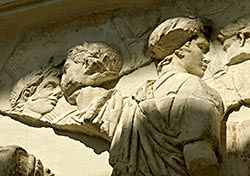
Same figures as in photo at left. photo May 2010
|